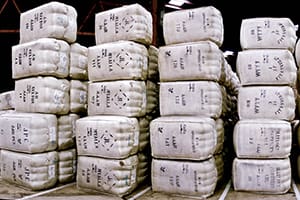 AUSTRALIAN wool prices fell further this week, hit by quality and global finance concerns, and exchange rate impacts.
AUSTRALIAN wool prices fell further this week, hit by quality and global finance concerns, and exchange rate impacts.
The AWEX Eastern Market Indicator fell for the third consecutive week, losing 29 cents to 1979c/kg clean, and despite brokers offering 40,785 bales, 4345 fewer than last week, they passed in 12.5 percent as seller resistance set in.
The EMI in US$ fell 18 cents to US1397c/kg clean, as the A4-US$ exchange rate rose 12 cents to US70.60 cents.
Australian Wool Innovation said the declining overall quality of wools available, soft enquiry and a slightly stronger Australian dollar and the US currency and the Chinese Yuan (CNY) were nominated as factors, but the much cheaper South African wool auction market was the primary cause.
AWI said the Australian wool values were unfortunately affected by the very weak market that arose out of South Africa on Wednesday, where wool shipments to China are still suspended due to a Foot and Mouth Disease outbreak.
“Whether we like it or not, wool is traded into, and under a generally free global market and the Port Elizabeth auction saw the Cape Wools Merino Indicator decrease by 3.3pc.
“While traditional Chinese buyers were operating in South Africa in the hope the ban would be lifted soon, the purchasing numbers appear to show that that support was wearing thin and waning,” AWI said in its weekly market report.
“The situation surrounding the import ban of RSA wool into China ultimately has proved detrimental to global wool pricing in the short term.
“The reality of the ongoing ban on RSA wool entering China means a huge amount of buyer/exporter finances are being tied up with wool that cannot be pulled through the supply chain and be paid for.”
AWI said the initial concerns surrounded South African growers being unable to sell their clips but the major effect was, and continues to be, buyer and exporter finance.
“There are plenty of FCL’s (full container loads of between 108 and 140 bales each) of RSA wools either delivered into CMP (Chinese main port), on the water to China, or being packed and bales bought and in brokers stores remaining in the buyers inventory with no payment forthcoming.”
Australian bale offering down 12.7pc
Senior AWEX market analyst Lionel Plunkett said when compared year-on-year, the total amount of bales offered in Australia has fallen by 176,192 bales, a reduction of 12.7pc.
“The quantity is expected to raise in Week 38, before falling to around 37,000 bales nationally in Weeks 39 and 40.”
He said the market this week followed a very similar pattern to the previous series.
“A diminishing supply of better style wools, in particular those possessing favourable additional measurement results, attracted excellent support and closed out the week achieving prices only 15 to 20 cents below the levels achieved in the previous week.
“However, there was again an ever-increasing supply of lower style/lower yielding types.”
He said the national average yield on Merino fleece was only 63.6pc dry, the lowest level in over 10 years.
“Buyers continually reduced their basis on these lower yielding wools, as they again struggled to average them into their purchases.”
Mr Plunkett said by the end of the sale series this week, these types were generally 30 to 50 cents cheaper.
“It was the large reductions in these wools which was the major factor in the individual Micron Price Guides (MPGs) falling as far as they did.”
Mr Plunkett said the crossbred wools also lost ground, with 26 to 30 micron lines generally 25 to 40 cents easier.
South African wool import suspension into China is hurting everyone
AWI said the longer the South African wool import suspension into China continues “the worse it will get.”
“These buyers will now have to liquidate these wools into other markets and now at prices much lower than what they paid, if they hadn’t already managed to re assign these deliveries.
“Obviously this has, and will continue to effect the spot auction results in the immediate term.”
AWI said South Africa is now very reliant on wool exports to China, with 70.6pc of its clip estimated to be going there — very similar to Australia.
“China is a relatively new participant in the South African market, with less than a decade of dominant buying activity.
“The production in South Africa is equivalent to around 14pc of what Australia produces, with 360 mkg here and 50mkg ex-South Africa in the 2017-18 season,” AWI said.
“Of those weights, around 63pc of the South African clip is white Merino quality (micron) compared to the 81pc of the Australian clip being Merino.”
AWI said Australian wool values were nonetheless less affected than in South Africa, but the negative sentiment did permeate through to our auction rooms, particularly on Thursday.
Next week 44,137 bales are rostered in Sydney, Melbourne and Fremantle rostered to sell and AWI said fresh orders are required to invigorate some life into the market.
“The lower quality wool types and descriptions remain dominant in offered volume and are getting harder to place into exporter orders, but this week did see some stronger interest from the top makers as the gaps widen between the better and average lots.”
Sources: AWEX, AWI.

HAVE YOUR SAY